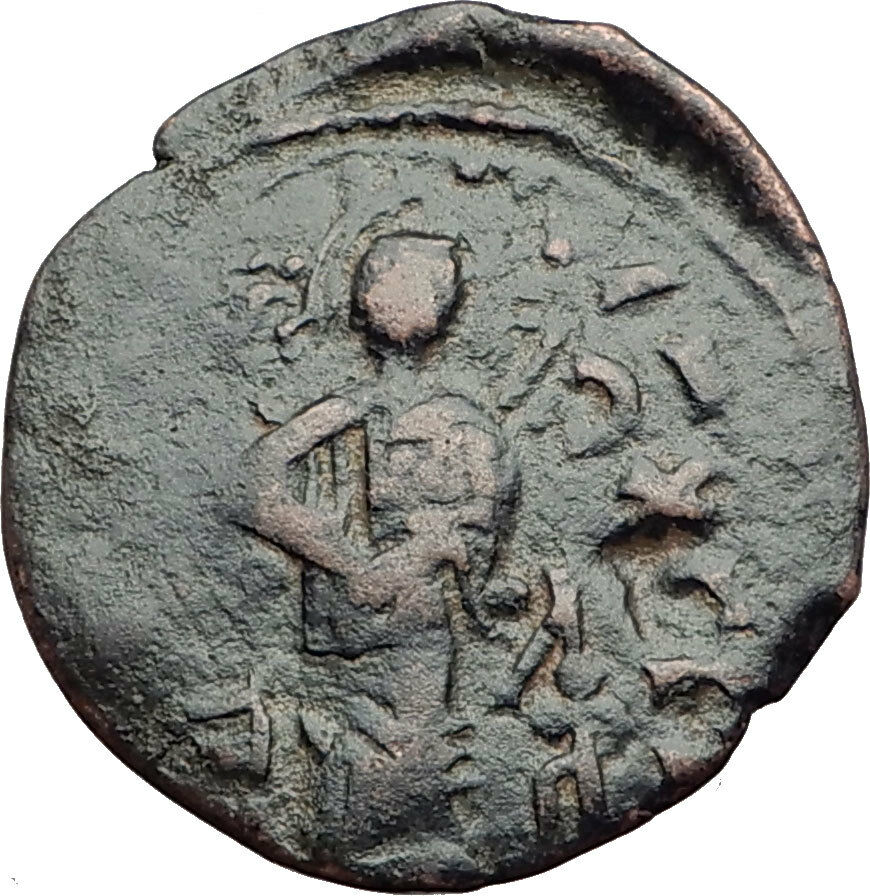|
ISLAMIC – Anatolia & al-Jazira (Post-Seljuk). Artuqids (Mardin).
Husam al-Din Yuluq Arslan, AH 580-597 / AD 1184-1200.
DEATH OF SALADIN TYPE
Bronze Dirham 30mm (12.20 grams) Struck 589 A.H. = 1192/1193 A.D.
Reference: Spengler & Sayles 35.3
Three figures with extended arms standing around one figure seated to left in attitude of mourning.
In inner field, ‘al-Imam al-Na/sir lil-din / Amir al-Mu’minin; around, ‘Husam al-Din Malik Diyarbakr Yuluq Arslan ibn il-Ghazi ibn Artuq’ and date in Kufiq.
The scene on the obverse has been interpreted either as the mourning over the death of Saladin, or as an astrological event depicting Virgo, the sixth astrological sign in the Zodiac, surrounded by planets.
You are bidding on the exact item pictured, provided with a Certificate of Authenticity and Lifetime Guarantee of Authenticity.
Al-Nasir Salah al-Din Yusuf ibn Ayyub (Arabic: الناصر صلاح الدين يوسف بن أيوب, romanized: An-Nāṣir Ṣalāḥ ad-Dīn Yūsuf ibn Ayyūb; Kurdish: سەلاحەدینی ئەییووبی, romanized: Selahedînê Eyûbî; 1137 – 4 March 1193), better known simply as Salah ad-Din or Saladin (/ˈsælədɪn/), was a Sunni Muslim Kurd and the first sultan of Egypt and Syria and founder of the Ayyubid dynasty. Saladin led the Muslim military campaign against the Crusader states in the Levant. At the height of his power, his sultanate spanned Egypt, Syria, the Jazira (Upper Mesopotamia), the Hejaz (western Arabia), Yemen, parts of western North Africa, and Nubia.
He was originally sent to Fatimid Egypt in 1164 alongside his uncle Shirkuh, a general of the Zengid army, on the orders of their lord Nur ad-Din to help restore Shawar as vizier of the teenage Fatimid caliph al-Adid. A power struggle ensued between Shirkuh and Shawar after the latter was reinstated. Saladin, meanwhile, climbed the ranks of the Fatimid government by virtue of his military successes against Crusader assaults against its territory and his personal closeness to al-Adid. After Shawar was assassinated and Shirkuh died in 1169, al-Adid appointed Saladin vizier, a rare nomination of a Sunni Muslim to such an important position in the Isma’ili Shia caliphate. During his tenure as vizier, Saladin began to undermine the Fatimid establishment and, following al-Adid’s death in 1171, he abolished the Fatimid Caliphate and realigned the country’s allegiance with the Sunni, Baghdad-based Abbasid Caliphate.
In the following years, he led forays against the Crusaders in Palestine, commissioned the successful conquest of Yemen, and staved off pro-Fatimid rebellions in Upper Egypt. Not long after Nur ad-Din’s death in 1174, Saladin launched his conquest of Syria, peacefully entering Damascus at the request of its governor. By mid-1175, Saladin had conquered Hama and Homs, inviting the animosity of other Zengid lords, the official rulers of Syria’s various regions. Soon after, he defeated the Zengid army at the Battle of the Horns of Hama and was thereafter proclaimed the “Sultan of Egypt and Syria” by the Abbasid caliph al-Mustadi. Saladin made further conquests in northern Syria and the Jazira, escaping two attempts on his life by Assassins, before returning to Egypt in 1177 to address issues there. By 1182, Saladin had completed the conquest of Muslim Syria after capturing Aleppo, but ultimately failed to take over the Zengid stronghold of Mosul.
Under Saladin’s command, the Ayyubid army defeated the Crusaders at the decisive Battle of Hattin in 1187, and thereafter wrested control of Palestine—including the city of Jerusalem—from the Crusaders, who had conquered the area 88 years earlier. Although the Crusader Kingdom of Jerusalem continued to exist until the late 13th century, its defeat at Hattin marked a turning point in its conflict with the Muslim powers of the region. Saladin died in Damascus in 1193, having given away much of his personal wealth to his subjects. He is buried in a mausoleum adjacent to the Umayyad Mosque. Saladin has become a prominent figure in Muslim, Arab, Turkish and Kurdish culture, and has been described as the most famous Kurd in history.
|










